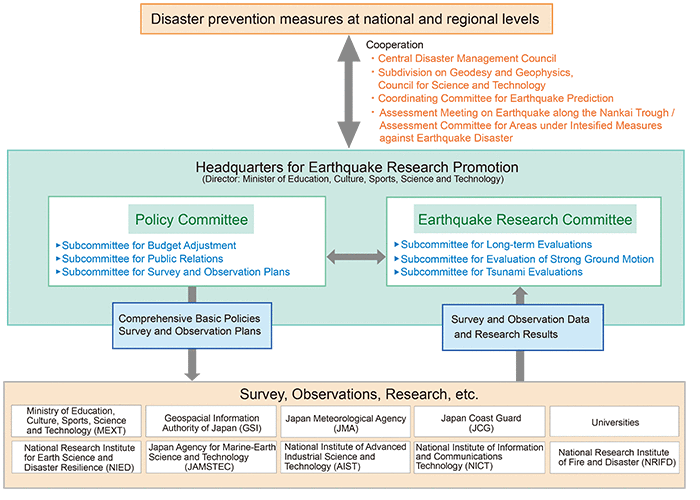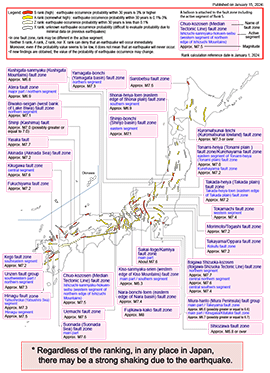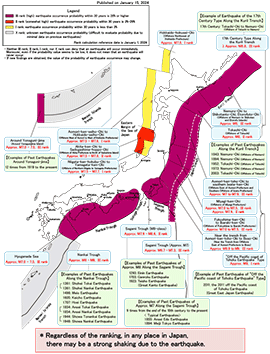
Click on the images for an enlarged view
The Great Hanshin-Awaji Earthquake Disaster on January 17, 1995 killed 6,434 people and destroyed over 100,000 buildings. This was the worst damage that Japan had suffered since the end of World War II. It also brought to light a number of problems in the national earthquake disaster prevention measures at the time.
Based on these problems, the Special Measure Law on Earthquake Disaster Prevention was enacted by legislators in July 1995. It was designed to promote a comprehensive national policy on earthquake disaster prevention.
The law recognized that the national system had failed to sufficiently communicate and apply the results of earthquake research to general public and disaster prevention organizations. As a result, the Headquarters for Earthquake Research Promotion was established in accordance with this law as a special governmental organization attached to the Prime Ministerís Office (it now belongs to the Ministry of Education, Culture, Sports, Science and Technology). It was established in order to clarify the systems of responsibility regarding earthquake research that is directly connected to government policy. It manages this in an integrated fashion with a governmental capacity.
(Basic objective)
To promote research of earthquakes in order to strengthen earthquake disaster prevention measures, especially for the reduction of damages from earthquake.
(Roles)
The Headquarters for Earthquake Research Promotion consists of a director (the Minister of Education, Culture, Sports, Science and Technology) and staff members (such as the vice ministers of related ministries and agencies). Underneath them are the "Policy Committee" and the "Earthquake Research Committee," composed of staff from related government offices and academia.
The "Policy Committee" implements the planning of basic policy concerning the promotion of earthquake research. It also coordinates budgets and other administrative work and deals with matters such as evaluation-based publications.
The "Earthquake Research Committee" holds regular meetings
on a monthly basis and classifies and analyzes research and observation results, as well as study outcomes. It does this in order to evaluate seismic activity in a comprehensive manner and to publish evaluation results. In addition, ad hoc meetings are held in response to damaging earthquakes or marked seismic activity. The meeting seeks to assess the current activity and the probability of aftershocks.
The probability of earthquake occurrence given in the figure is usually only a few percent. This might seem small, but this value does not mean that we are free from earthquakes and are safe.
For example, the probability of getting killed in a traffic accident within 30 years is approximately 0.1%*1. If you compare this value with that of an earthquake, you can see that the probability of earthquake occurrence is not so small. Furthermore, an earthquake can, even if the occurrence probability is low, inflict enormous damages once it occurs. It is important to consider its possible extent of damages when accepting this probability.
*1 Calculated based on the statistics from the White Paper published by the Fire and Disaster Management Agency, using a specific assumption.
| Evaluation of Major Active Faults | Evaluation of Subduction Zone Earthquakes | |
 |
 |
|
The Probabilistic Seismic Hazard Maps indicate the "possibilities of strong shaking within a certain period at every location on the map."
In preparing this map, all earthquakes that might influence a particular area have been considered. The considered earthquakes in these maps consist of not only earthquakes that have already been through long-term evaluation, but also earthquakes that are difficult to find source faults for before they occur. This includes earthquakes that occur in an area where no active fault has yet been found.
For the probabilistic seismic hazard maps, three quantities are used. These are the "time span," "intensity of shakes," and "probability." To present the maps, a convention was adopted so that two of the quantities were fixed to show the distribution of the remaining quantity. For example, below is a distribution map of "probability," that is shown with the "time period" and "intensity of ground motion" fixed. Reports on the Probabilistic Seismic Hazard Map are publicly available on the Headquarters for Earthquake Research Promotion's website.
Seismic hazard maps can also be seen on the website of the National Research Institute for Earth Science and Disaster Prevention (NIED), "Japan Seismic Hazard Information Station (J-SHIS)." You can zoom-in on the map, find out "the probability of ground motion equal to or larger than seismic intensities of 6 lower, occurring within 30 years from the present," or the "ground susceptibility to shaking." You can also check the main active faults or the hypocentral regions of subduction zone earthquakes. Seismic hazard maps are revised every year.